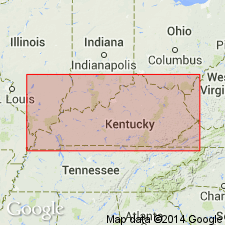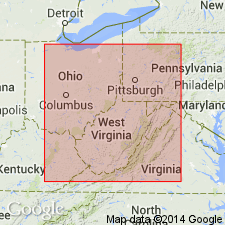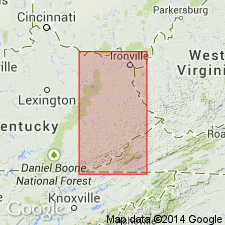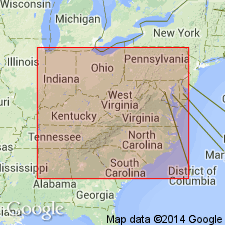
- Usage in publication:
-
- Kilgore flint
- Modifications:
-
- Not used
- AAPG geologic province:
-
- Appalachian basin
Summary:
Breathitt Formation is informally elevated to group rank and subdivided into the following eight informal formations: Pocahontas, Bottom Creek, Alvy Creek, Grundy, Pikeville, Hyden, Four Corners, and Princess formations. Kilgore flint and the Flint Ridge flint [both reduced to informal status] are approximately at the same stratigraphic level, overlying the Richardson coal bed and therefore are treated together here as the Flint Ridge flint, here assigned to the Princess formation. The Flint Ridge underlies Princess Nos. 5A and 5B coals. Age shown as Middle Pennsylvanian (Atokan). [Revisions made in this paper are strongly contested by C. Rice and other USGS scientists who work in this area (oral commun., 9/3/93).]
Source: GNU records (USGS DDS-6; Reston GNULEX).

- Usage in publication:
-
- Kilgore Flint Member*
- Modifications:
-
- Original reference
- Dominant lithology:
-
- Chert
- Siltstone
- AAPG geologic province:
-
- Appalachian basin
Summary:
Formally named as a member of the Breathitt Formation. Named for Kilgore, northeastern KY. Formerly called Kilgore flint by Webb (1963). Occurs in small area (41 sq km) in northeastern KY. Consists of fossiliferous chert and silicified siltstone. Thickness is about 3.7 m. Locally overlies Princess No. 5 coal bed; no overlying beds described. Correlates with Flint Ridge flint (Breathitt Formation) of Morse (1931) in KY, Limekiln limestone of Johnston (1962) in northeastern KY, Kanawha black flint of Wanless (1939, 1975) in Kanawha Formation in WV, and Putnam Hill Limestone Member of the Allegheny Formation in OH. Age is Middle Pennsylvanian. Report includes geologic map, correlation diagram, and stratigraphic nomenclature chart.
Source: GNU records (USGS DDS-6; Reston GNULEX).

- Usage in publication:
-
- Kilgore Flint Member*
- Modifications:
-
- Areal extent
- AAPG geologic province:
-
- Appalachian basin
Summary:
Kilgore Flint Member of Breathitt Formation. (Is = Limekiln limestone of Johnston, 1962, USGS GQ-181, in Lenox quadrangle, Licking River district, eastern Kentucky; and Flint Ridge flint of Morse, 1931, in Hazard district, eastern Kentucky.) [Chert and silicified siltstone about 12 feet thick] in upper part of Breathitt Formation below Obryan Member and above Magoffin Member; between the Princess No. 5A (or Lower No. 5 Block) coal bed above and the Princess No. 5 coal bed (or Richardson, Stockton coal zones) below. [Fossils.] Age is Middle Pennsylvanian.
Recognized locally in Princess district, eastern KY.
[See Rice and others, 1994, GSA Spec. Paper 294, p. 11-13; see also Rice and others, same vol., p. 131.]
Source: Publication.

- Usage in publication:
-
- Kilgore Flint Member
- Modifications:
-
- Areal extent
- AAPG geologic province:
-
- Appalachian basin
Summary:
Corr. chart. Kilgore Flint Member of Princess Formation of Breathitt Group. Limestone and/or chert. (Includes rocks informally called Flint Ridge flint and Limekiln limestone.) Recognized in eastern Kentucky. Lies in lower part of formation, below the Princess 5A (Little No. 5 Block, Laurel) coal bed and above the Princess No. 5 (Hazard No. 11, Knob) coal bed. Correlates with Kanawha Black Flint, an unranked unit at top of Kanawha Formation of Pottsville Group in West Virginia, and Putnam Hill limestone (Putnam Hill shale), an informal, unranked unit in lower part of Allegheny Group in Ohio. Top of member approximately = top of Cross Mountain Formation of Tennessee. Age is Middle Pennsylvanian (Westphalian; late Atokan).
[Peppers (1996, GSA Memoir 188, pl.) placed the Princess No. 5A and Princess No. 5 coal beds in upper part of Westphalian C, TORISPORA SECURIS-T. LAEVIGATA (SL) miospore assemblage zone of western Europe. Eble and others (2009, Kentucky Geol. Survey, Spec. Pub. no. 10, ser. XII, figs. 5.2) placed the correlative Kanawha Black Flint in upper part of Bolsovian (upper part of Westphalian C) on basis of miospores.]
[See also Chesnut, 1997 (revised Oct. 12, 1999), Stratigraphy of the coal-bearing strata of the Eastern Kentucky coal field, available online through the Kentucky Geol. Survey (http://www.uky.edu/KGS/coal/coalcorrel.htm).]
Source: Publication.
For more information, please contact Nancy Stamm, Geologic Names Committee Secretary.
Asterisk (*) indicates published by U.S. Geological Survey authors.
"No current usage" (†) implies that a name has been abandoned or has fallen into disuse. Former usage and, if known, replacement name given in parentheses ( ).
Slash (/) indicates name conflicts with nomenclatural guidelines (CSN, 1933; ACSN, 1961, 1970; NACSN, 1983, 2005, 2021). May be explained within brackets ([ ]).

